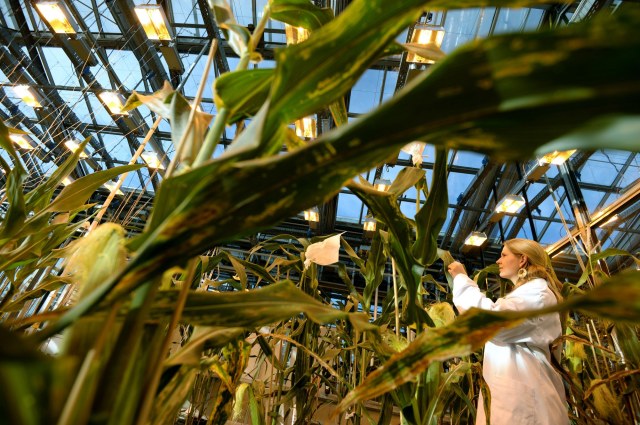Ralf Hirschberger/DPA/PA Images

The controversy over genetically modified organisms has been raging for a generation now. In large parts of the world – such as Europe – the technology is no nearer to being accepted by the public.
The concept of transferring genes between unrelated species is almost certainly the main sticking point. However, as Antonio Regalado explains for MIT Technology Review, new gene editing techniques, such as CRISPR and TALEN, allow modification to take place entirely within the genome of one species:
“The virtue of the technology is that it lets scientists create designer plants that don’t have foreign DNA in them. The technique, which adds or deletes snippets of genetic information, is similar to what could be achieved through conventional breeding, only much faster. In essence, if there’s some quality about a soybean that you like, and if you know the genetic instructions responsible, gene editing can move them to another bean in a single molecular step.
“To many scientists, the potential of gene editing seems nearly limitless, offering a new way to rapidly create plants that are drought-resistant, immune to disease, or improved in flavor… If nature allows it, scientists believe, gene editing could let them build it.”
Because these techniques are non-transgenic (i.e. no cross-species malarkey), the process of regulatory approval for new crop varieties could be less onerous (as already appears to be the case in the US). We could therefore be on the brink of a era of much faster, cheaper and more ambitious genetic modification.
But is there a catch? Writing for Independent Science News, Jonathan Latham certainly thinks so. He attacks the hype surrounding the new gene editing techniques – especially CRISPR. It’s not the power of the technology that he doubts, but rather the language of precision and control that is typical of its coverage in the media.
For a start, he points to evidence that “CRISPR may act at unknown sites in the genome where it is not wanted” i.e. it can induce genetic changes other than those intended. But for the sake of argument, let’s assume that we can perfect the technique so that we only make the edits we want to make – would that make it all OK?
Not really. Even if we could limit the edit to the target gene, complete control over the impact of that edit would depend on us knowing everything that the gene in question does – the problem being that a gene can have several functions, one or some of which we don’t yet know about.
Then there’s the fact that genes don’t necessarily act alone, but more likely in conjunction with other genes and various non-genetic factors:
“The concept of the precise editing of a genome leading to a precise biological outcome depends heavily on the conception that genes give rise to simple outputs…
“However, a defined, discrete or simple pathway from gene to trait probably never exists. Most gene function is mediated murkily through highly complex biochemical and other networks that depend on many conditional factors, such as the presence of other genes and their variants, on the environment, on the age of the organism, on chance, and so forth.”
Unless we understand this web of interactions, we don’t understand what editing one its key components will do the modified organism and therefore to the environment in which the organism is released.
Latham warns us against “naive genetic determinism” or the idea that CRISPR will turn living things into “robots being operated by mini-dictators”. While the new techniques will allow us to manipulate genomes in ways that weren’t previously possible, that novelty only makes the consequences of our interference more unpredictable.
We should never forget that the market for new crop varieties is a global one. Therefore it is the global food system that is at stake here. The chances of something going profoundly wrong may be very small, but the consequences are so huge as to merit the most serious of precautions.










Join the discussion
Join like minded readers that support our journalism by becoming a paid subscriber
To join the discussion in the comments, become a paid subscriber.
Join like minded readers that support our journalism, read unlimited articles and enjoy other subscriber-only benefits.
Subscribe